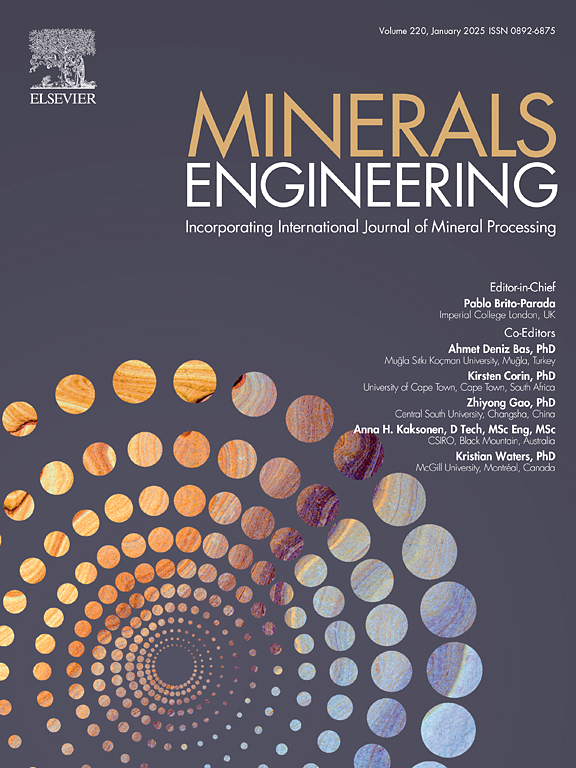In-depth analysis of the dynamic features and screening performance of high-elasticity projection vibrating screen
IF 5
2区 工程技术
Q1 ENGINEERING, CHEMICAL
引用次数: 0
Abstract
With the increasingly stringent requirements of industrial production on the particle size of the material, dry depth screening technology came into being. In order to further realize effective separation and efficient classification of fine-grained coal, a new high-elasticity screen surface equipped with additional striking shaft was designed in this paper. The performance of vibrating screen was explored by combining theoretical modeling, vibration testing, numerical simulation, and screening tests. The dynamical model of the vibrating screen was established using concentrated mass method, showing that the equipment underwent a linear motion of low vibration intensity perpendicular to the screen surface. The trajectories of the machine and the striking shaft under different excitation parameters obtained from the vibration test showed regular straight lines, and the relative errors between the theoretical and actual displacements were controlled within 3 %. The dynamics of an elastic screen surface of a four-sided simply supported shaft was built, and expression for its transient steady-state response to an impact was derived. Vibration tests showed that the spatial trajectory of the screen surface was relatively chaotic, but the maximum acceleration could be as high as 304.61 m/s2, and the displacement reached 30.31 mm, which promoted the movement of particles with high ejection intensity. In contrast, the elastic screen surface under simulation exhibited hysteresis and nonlinearity, and the excitation parameters significantly affected the contact stresses and forces, with significant peaks in stresses and contact forces at L = 7.5 cm and f = 11.4 Hz, and the largest displacements and penetrations generated at point P1. Additionally, 3 mm classification tests were carried out for sticky-wet materials with different excitation forces, frequencies and shaft distance to optimize the processing parameters, and it was found that when F = 19 kN, f = 12.0 Hz, Δl = −0.5 and kl = 0.938, the screening efficiency was up to 92.45 % and the total mismatched content was only 4.78 %. The paper discussed the relationship between additional striking shafts, elastic screen surfaces, and classification effects, aiming to provide theoretical and technical guidance for elastic screening equipment.
深入分析了高弹性投影振动筛的动态特性和筛分性能
随着工业生产对物料粒度的要求越来越严格,干式深度筛分技术应运而生。为了进一步实现细粒煤的有效分离和高效分级,本文设计了一种新型的高弹性筛面,并加装了冲击轴。采用理论建模、振动试验、数值模拟和筛分试验相结合的方法对振动筛的性能进行了探索。采用集中质量法建立了振动筛的动力学模型,表明该设备垂直于筛面进行了低振动强度的直线运动。振动试验结果表明,在不同激励参数下,机床与冲击轴的运动轨迹呈规则的直线,理论位移与实际位移的相对误差控制在3%以内。建立了四边简支轴弹性筛网表面的动力学模型,推导了其在冲击作用下的瞬态稳态响应表达式。振动试验表明,筛面空间轨迹相对混沌,但最大加速度可高达304.61 m/s2,位移达到30.31 mm,促进了高弹射强度颗粒的运动。相比之下,模拟下的弹性屏表面表现出滞后性和非线性,激励参数对接触应力和接触力的影响显著,在L = 7.5 cm和f = 11.4 Hz处应力和接触力达到峰值,P1点产生的位移和穿透量最大。并对不同激振力、频率、轴距的粘湿物料进行了3 mm分级试验,优化了工艺参数,结果表明:当F = 19 kN、F = 12.0 Hz、Δl =−0.5、kl = 0.938时,筛分效率可达92.45%,总失配率仅为4.78%。本文探讨了附加冲击轴、弹性筛面与分级效果之间的关系,旨在为弹性筛分设备提供理论和技术指导。
本文章由计算机程序翻译,如有差异,请以英文原文为准。
求助全文
约1分钟内获得全文
求助全文
来源期刊

Minerals Engineering
工程技术-工程:化工
CiteScore
8.70
自引率
18.80%
发文量
519
审稿时长
81 days
期刊介绍:
The purpose of the journal is to provide for the rapid publication of topical papers featuring the latest developments in the allied fields of mineral processing and extractive metallurgy. Its wide ranging coverage of research and practical (operating) topics includes physical separation methods, such as comminution, flotation concentration and dewatering, chemical methods such as bio-, hydro-, and electro-metallurgy, analytical techniques, process control, simulation and instrumentation, and mineralogical aspects of processing. Environmental issues, particularly those pertaining to sustainable development, will also be strongly covered.
 求助内容:
求助内容: 应助结果提醒方式:
应助结果提醒方式:


